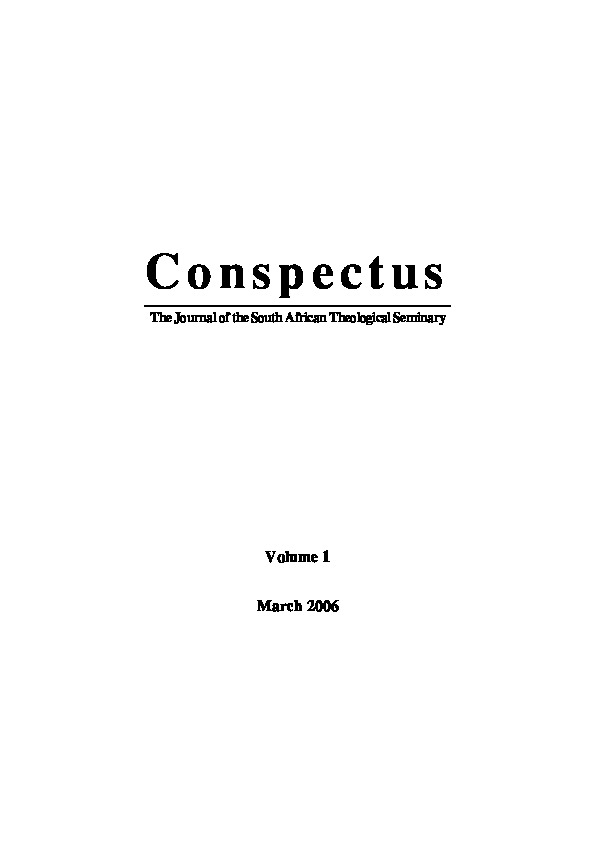Family Requirements for Eldership
What is the most important criterion for appointing an elder in a local church? The three areas that are usually considered are calling, charisma and character. Although in practice character is often relegated to third place, both the biblical lists of requirements for eldership give it pride of place (see 1 Tim 3:1-7 and Tit 1:5-9). In fact, they deal almost exclusively with character matters. Although it may not always be consistently applied, the fact that the lists prioritise godliness over giftedness is never questioned. The question that is seldom asked is whether some aspects of candidates’ character should be given priority when evaluating them for eldership. The first part of this article will demonstrate that the two lists of requirements for eldership not only emphasise character, but also give pride of place to the character of a candidate’s family life. Within the construction of the two lists, the family requirements hold centre stage. The candidate’s family life is the most important area to be evaluated when assessing his eligibility for eldership. If the family requirements are most emphasised, what exactly are those requirements? Scholars have proposed varied interpretations of the family requirements. The second part of the article will review those proposals, analyse the interpretive difficulties and conclude with some proposals as to what is a required of elders with respect to their character as husbands and fathers.
Progressive Covenantalism as an Integrative Motif of Scripture
Progressive covenantalism is a new working model for comprehending the relationship between the Old and New Testaments. The goal is to articulate a consistent understanding of how to put together seemingly heterogeneous portions of Scripture. This integrating motif asserts that God’s progressive revelation of His covenants is an extension of the kingdom blessings He first introduced in creation. Affiliated claims are that the various covenants revealed in Scripture are interrelated and build on one another, that the people of God throughout the history of salvation are united, and that they equally share in His eschatological promises. The notion of “progressive dispensationalism” has been around for a number of years, as reflected in the publication Continuity and Discontinuity (Feinberg 1988a; cf. Blaising and Bock 1993; Willis and Master 1994), but the idea of “progressive covenantalism” was different, especially as presented by individuals who did their graduate studies at Dallas Theological Seminary, an academic institution long known for its dispensational leanings. Patton and Dyck’s intent was to come up with a consistent understanding of how to put together seemingly heterogeneous portions of Scripture. Concededly, they do not give an elaborate explanation of what they mean by progressive covenantalism. Nonetheless, the comments they make in their lecture provide a useful starting point for proposing a new working model of how to understand the relationship between the Old and New Testaments. (As a disclaimer, my elaboration of what Patton and Dyck have proposed concerning progressive covenantalism reflects my own views, not necessarily theirs.) This endeavour mirrors the ongoing task of theology. As König explains, “theology is not merely repeating what is written in the Bible but rather rethinking the biblical material” so as to foster greater understanding (1994:182; italics are his).
The Exegetical Method Employed in 1 Peter 2:4-10
The New Testament writers employed conventional Jewish exegetical techniques of the New Testament era to interpret the Old Testament, but contemporary New Testament interpreters often fail to identify correctly the exegetical methods being employed. Using 1 Peter 2:4-10 as a test case, this article demonstrates the process of identifying the exegetical method New Testament authors used to interpret the Old Testament. One key is for interpreters to rely less on formulaic introductions and phrases as keys to identifying exegetical methods and to take all facets of the methodologies into account.
Ministering in the Tabernacle: Spatiality and the Christology of Hebrews
Two of the perplexing features of Hebrews, its Christological comparisons and the spatial emphases are intertwined. Application of appropriate sociological and literary theories in Spatiality to examine the expositions in the epistle will demonstrate that the author used the spaces of the Pentateuchal wilderness camp and tabernacle as his heuristic and typological tool for the Christological expositions. This served as the primary vehicle for channelling his pastoral teaching aimed at addressing the problems of social liminality and spiritual malaise of the congregation. The author’s approach should serve as template for our understanding and applications of the theology of the tabernacle.
Volume 1
March 2006
Justification as it relates to Adam and Christ within the New Covenant
How does one grasp the ramifications of sin without first understanding its source and how it was transmitted to all mankind? How does one understand the depth of Christ’s redemptive act without first understanding the depth of sin within man? The significance of this concept in explaining the work of Christ should not be underestimated in any way. Therefore Paul teaches that all people stand in relationship to one of two men, whose actions determine the eternal destiny of all who belong to them. By the one man’s disobedience many were made sinners, and by the obedience of the other, many shall be made righteous.

